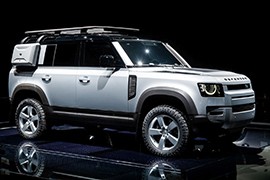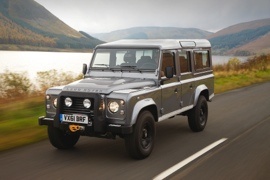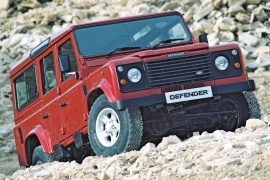LAND ROVER Defender 110 Models/Series Timeline, Specifications & Photos
First production year: 1991
Engines: Diesel, Gasoline, Hybrid gasoline, Mild hybrid diesel
Body style: SUV (Sports Utility Vehicle)
Land Rover Defender returned to the market after a four-year hiatus, and it was a revolution compared to its famous, older sibling. The 2019 Defender was ready for the 21st century.
When Rover introduced the Series 1 in 1948 as the Land Rover, it was mostly an agricultural vehicle built to take its owners to the field and back and work all day long. But the little rugged car evolved, and the Land Rover became a distinct brand from the Rover three decades later, in 1978. It was already known as an off-road vehicle manufacturer. The old Series I evolved into the Series II, and then, in 1989, these were replaced by the Defender. After three unsuccessful marriages, one with Honda, the second with BMW, and the third with Ford, Land Rover ended up together with its Jaguar sibling in Tata Motor Company. The new owner paid for the development of the Defender’s second generation, which was launched in September 2019 at the Frankfurt Motor Show.
For the new generation, Land Rover made a unibody construction for the vehicle, ditching the body-on-frame structure that was previously used. The 110, which was the five-door, long-wheelbase version, shared its front fascia with the rest of the range. It featured a pair of headlights adorned by circular LED daytime running lights, which resembled the older headlights used on the 1989 Defender. Its plastic bumper was extended in the lower area by an underbody shield. From its sides, the flared wheel arches and the flat door panels resembled those from its predecessor. Behind the rear doors, the automaker placed a wider C-pillar. The flat, vertical cut at the rear with the externally mounted spare wheel was also charismatic for this model. At the back, the taillights sported a rectangular shape with small LED lamps.
Inside, it was a modern vehicle fitted with all the features and amenities of an upscale off-roader. There was a digital instrument cluster instead of analog dials and a landscape-oriented touchscreen for the infotainment system on top of the center. Between the comfortable front seats, Land Rover installed a tall center console that housed a few storage areas and an armrest. The gear selector for the automatic transmission found its place closer to the dashboard, like in the old days. In the back, passengers could share the split-folding bench seat and had enough legroom and headroom. In addition, the automaker offered a jump seat between the front passengers or two folding seats in the trunk.
Under the hood, Land Rover installed a choice of diesel and gasoline engines mated to standard eight-speed automatic transmissions. Like its predecessor, it was an all-wheel-drive vehicle and featured a two-speed transfer case. But, unlike that, the 2020 Defender 110 was also available with air suspension, which could raise or lower the vehicle.
The old Defender that emerged from the Series III Land Rover received a final update in 2012 before being withdrawn from the market four years later, in 2016.
Born out of necessity in the late '40s, the Land Rover was a utility/family transportation vehicle that was constantly updated in the years to come several times. After it was named Series I, II, and III, the vehicle sported the name 90/110, according to the version's wheelbase. In 1990 the car got a new name: Defender. That version was constantly upgraded. But the upgrades couldn't overcome the foundation of the vehicle, which was a rugged chassis. Moreover, apart from the emission levels, the car couldn't meet the safety standards required for a Euro6 vehicle.
For the 2012 model year, the Defender got a slightly restyled front fascia with black trims around the headlights. The slatted grille was the same and still made from plastic. The bumper, though, was still from solid metal. But the door mirrors were still black and only manually adjustable by rocking them from the outside. The long wheelbase version, known as the Defender 110, sported a four-door bodywork and a fifth door, side-hinged, in the back.
Inside, the 2012 Defender couldn't be too much upgraded. As an option, it featured sort of an infotainment system, with a screen bolted atop the center stack. An AC unit blew cold air only through the mid-vents. In the instrument cluster, the old dials sported silver surroundings and green illumination. Like its predecessors, the 110 was available with either a five-seat or a seven-seat interior.
The most important upgrade was under the hood, where the Defender 110 got a 2.2-liter, Ford-sourced turbodiesel. It was an evolution of the powerplant installed in the Ford Transit utility vehicle, upgraded to Euro 5 emission standards. The only transmission available was a six-speed manual and a two-speed transfer case that sent the power in all corners.
The Defender name was introduced on the market in 1990 as a true successor for the Land Rover 90/110 and re-ignited the appeal for hard-core off-road vehicles.
With a vast history behind it and a similarly-shaped bodywork, the Defender lived up to its name and offered an authentic, hard-core experience. But despite that, newer safety and emission regulations forced the carmaker to improve the car. In 1997, the 1990 Defender had to adapt and become cleaner.
At the time of its development, Land Rover was owned by Ford, and the blue-oval carmaker found the facelift as an opportunity to sell more of its Transit turbo-diesel engines. Land Rover had to lose its 2.4-liter TD5 engine. The new unit was shorter but taller, and that led to a hood modification. It sported a wide power bulge, and the vent flaps were removed from the bottom of the windshield.
The Defender 110 featured a longer wheelbase (110"), and that made room for more people inside. Due to safety regulations, the carmaker had to install only face-forward seats, and that led to a maximum of seven seats instead of nine as before when it had side-mounted benches in the trunk. Land Rover installed a modular dashboard, which allowed an easier LHD and RHD manufacturing process. A new HVAC unit was installed in the center stack, and the AC had its separate vents.
Under the hood, the carmaker lost its TD5 engine, which was unsuitable for the new European pollution norms, and replaced it with Ford's inline-four 2.4-liter unit from the Transit. It was paired to a new 6-speed gearbox. Its all-wheel-drive system featured a transfer box with low-range gear and a locking center differential. Unlike its main rival, the Land Cruiser, the Defender 110 was not available with a rear locking differential.
Land Rover continued the Series I, II, and III range with the 90 and 110 models in the '80s and then introduced the Defender nameplate in late 1990.
After decades of producing the Land Rover Series models, the British carmaker finally decided on giving a proper name to the iconic off-road vehicle: Defender. It replaced the former 90 and 110 nameplates and became Defender 90 and Defender 110, respectively. Later on, Land Rover longer version named Defender 130.
In 1991, the off-road vehicle featured a ladder chassis and an aluminum bodywork. Its squared shape helped the driver see better the surrounding area. The flat front fascia sported a black grille, two round headlights, and smaller lamps for turn signals and parking lights. Unlike the shorter Defender 90, the 110 version featured a 110" (2,794 mm) wheelbase and four doors. At the back, a side-hinged door allowed access to the trunk or to the additional side-mounted seats.
Inside, the carmaker placed the driver's seat very close to the door card, and the steering was shifted toward the car's center. It was one of the most difficult driving positions in the industry, but it was a considerable advantage while going off-road. The driver just had to tilt its head on the outside to see the car's front wheels. In the back, the Defender featured a bench for three people with enough headroom and shoulder room but limited legroom. Behind the bench, the carmaker offered an option for side-mounted benches or just a loading area.
Under the hood, Land Rover installed either a 3.5-liter V-8 gasoline engine or a 2.5-liter turbo-diesel. Later on, it dropped the V-8 unit and improved the turbo-diesel powerplant. When Ford bought Rover, it replaced the older 2.5-liter inline-five with a 2.2-liter inline-four used on the Transit utility vehicle. The Defender featured live axles, both front and rear, and coil springs. A low-range transfer case allowed an all-wheel-drive system with a locking center differential.



